Epping Forest Centenary Walk
Manor Park to Epping, Mon 31 Aug 2009
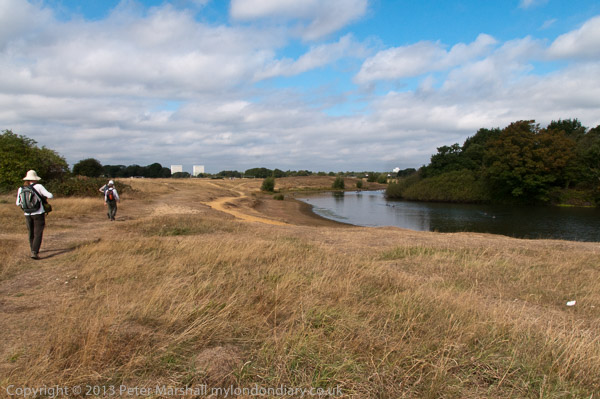 We
walk across Wanstead flats - towards the Montague Rd flats
We
walk across Wanstead flats - towards the Montague Rd flats
more pictures
Every year in September, the Friends of Epping Forest organise a walk
through the forest from Manor Park station to Epping. The route was
developed in 1978 to commemorate the 100th anniversary of the Epping
Forest Act, 1878. But we did the 16 mile walk (and perhaps a little more
as we occasionally found ourselves a little lost) on our own.
It wasn't the first Epping Forest Act, but it placed the former royal
forest in the care of the City of London Corporation and gave them
powers to halt and partly reverse the enclosures that were rapidly
reducing the size of the forest. The City as Conservators were required
to "at all times keep Epping Forest unenclosed and unbuilt on as an open
space for the recreation and enjoyment of the people", and have
continued to do so - with an exception for the London 2012 Olympics when
a legislative reform order allowed a temporary police centre to be built
on Wanstead flats, despite considerable local opposition.
Although in general the City have played an important part in
preserving the forest, at times - such as the Olympics - they have let
other interests interfere with their role under the 1878 Act. There
activities are now closely watched by 'The Friends of Epping Forest', a
group initially formed to oppose the M25 route which would have cut off
a corner of the forest at Epping. Their opposition led to the M25 being
put in a tunnel under the forest. But around 10 years later, in 1989-94,
a large section at the south of the forest was lost to build the M11
link road.
more pictures
Notting Hill - Children's Day
Notting Hill, London. Sun 30 Aug 2009
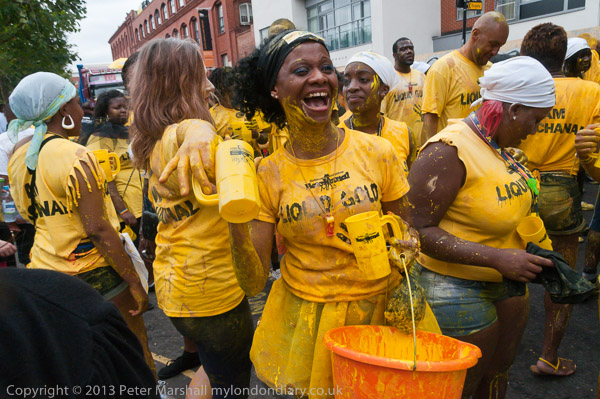
Liquid Gold. I think it washed off me without too
much difficulty
more pictures
I spent a few hours in Notting Hill and took a lot of pictures -
here are just a few of those I liked. I didn't get around to putting
them on line in 2009, and only remembered them again in 2014 when
August bank holiday was so wet I stayed home and didn't go to
carnival.
more pictures
Climate Camp: Saturday
Blackheath Common, London. Saturday 29 Aug
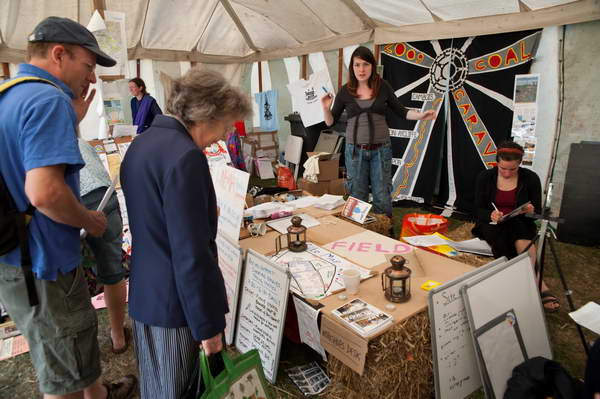
Welcome tent at the Climate Camp
more pictures
I've had an active interest in the environment since my student days in
the late 60s, speaking in public on some of what were then seen as the
major issues, particularly pollution and resource depletion. At that
time, although we were aware of the increase in CO2 levels and global
warming, the significance of the greenhouse effect was not fully
realised.
I first put pictures of an environmental protes on the web in 1996,
and those very dated looking pages with primitively scanned images of
the Reclaim the Streets West
Cross Route Party remain on line, but of course I'd been
photographing events before this. And in 2007 I was very pleased to have
an exhibition of some of my pictures of environmental protest in London
shown at Fotoarte
2007 in Brasilia.
A sash showing I was a part of the Climate Camp documentation team did
make taking pictures easier, but I still came across a certain amount of
hostility to photography. There were some 'no media' areas marked, and
although strictly this did not apply to the documentation team, I
largely steered clear of them. I was also asked not to photograph two
particular events, and a few people declined my request to take their
picture. But in general people were friendly, cooperative and helpful
and some clearly enjoyed having their pictures taken.
It would be hard to visit the site and not be impressed by the
organisation of the Climate Camp. There also seemed to be plenty of
people volunteering to do the various jobs needed. In the workshop
sessions, some of the events were very well attended with marquees
overflowing, and I was impressed by some of the speakers and contibutors
I briefly listened to.
I've read a few silly things about the Camp in the press and on the
web, both in articles and more commonly in the comments made on them.
What I think they all had in common was that they were by people -
journalists and the public - who hadn't been there to actually see what
was taking place.
There were no uniformed police on the site, and no need for them. This
was almost certainly the most caring and most law-abiding part of South
London, with no crime, no drugs and very little alcohol around. As I
walked around the outer area of the site at one point I looked up and
saw one of the the police cameras on their cherry picker following me
around, and later when I left the site and went to photograph it more
closely, I was then followed rather ineptly (perhaps deliberately so) by
a young black man in plain clothes as I wandered around for the next 15
minutes, occasionally writing in his notebook. It seemed a waste of
public money.
more pictures
Climate Camp: Setup
Blackheath Common, London. Wednesday 26 Aug
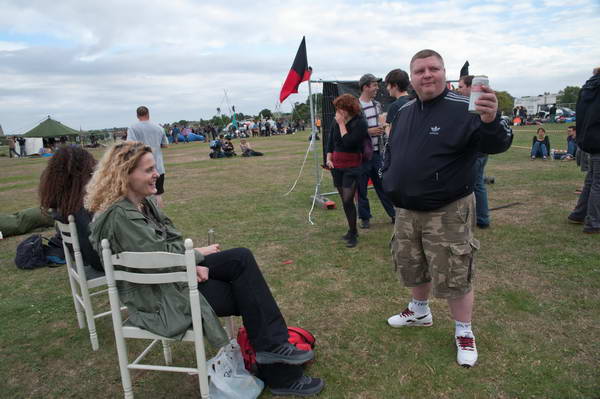
Whitechapel Anarchists settle in - but not for
long as most apparently left after a little 'anti-pig' action when two
officers came on site in the evening
more pictures
Climate Campers converged from six locations around London
onto the common at Blackheath on Wednesday afternoon. It's a large area
of common land fairly close to the centre of London, with stations
nearby at Greenwich (DLR and Overground), Lewisham and Blackheath, and
which is used occasionally for other festivals and fairs, in particular
an annual kite festival and a fireworks display, and is far enough away
from local housing to cause no great nuisance. The Climate Camp has a
good record for putting in the necessary plumbing and other necessities
and also for cleaning up sites well when the camp is over.
Lewisham, the borough in which the site lies, is also one of London's
greener boroughs, with six green councillors including Darren Johnson.
Local Green party members here and in neighbouring Greenwich (just
across the main road at the north of the site) have welcomed the Climate
Camp in their area.
It's almost certainly a coincidence that it is more or less on the
Greenwich Meridian, but not that this was the site where radical cleric
John Ball made what is described as the first speech against
class oppression, with its famous "When Adam delved and Eve span,
who was then the gentleman?" and urged his peasant audience to "cast
off the yoke of bondage, and recover liberty."
The Peasant's Revolt of 1381 ended unhappily, and Ball was
hung, drawn and quartered the following month while the teenage King
Richard II looked on as the priest was bfirefly hung and then carefully
kept alive to watch his genitals and bowels being removed and burnt
before he was beheaded and his body hacked into four pieces. Ball’s fate
didn't stop Jack Cade leading a further popular revolt to
also camp at Blackheath Common on its way to London in 1450, although
Cade was fortunate to be killed in a battle before he could be hung,
drawn and quartered; like Ball, his head was then displayed on London
Bridge.
The Climate Camp are hoping for somewhat better treatment by the
authorities, and on Wednesday at least the police were content to police
at arms length. While I was there on Wednesday afternoon there were no
police on site, although a helicopter was hovering above, and presumably
filming all those taking part. With stabilised cameras the image quality
should have been high enough for them to match the faces against their
database (which of course they claim does not exist.)
Although I was able to photograph freely while I was there on Wednesday
afternoon, the Climate Camp aims to control the activities of the press
on site. Press photographers visiting the site will be required to sign
a media policy that most of us would find unacceptable and to
be accompanied while on the site by a minder. (It can't of course apply
to the police photographers in their helicopter or cherry picker.) The
policy appears to be driven by a few individuals with paranoid ideas
about privacy and a totally irrational fear of being photographed. It
really does not steal your soul!
more pictures
Climate Camp: Blue Group Stockwell Swoop
Stockwell to Blackheath, London. Wednesday 26 Aug
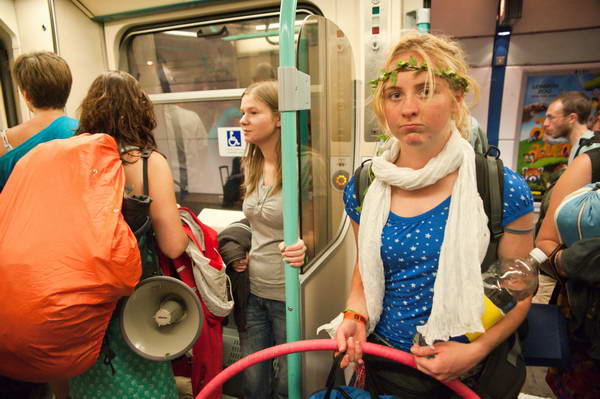
We changed on to the DLR at Bank station
more pictures
I chose to go with the Blue Group which was starting from Stockwell
Underground Station in south London, chosen as a starting point because
of the events of 22 July 2005.
Coming up the escalator at Stockwell station it's hard not to shiver at
the memory of those videos showing Jean Charles de Menezes strolling
down to catch his last train, and police coming though the gates in
pursuit. There is a memorial to him outside the station, including a
great deal of information about the event and the misinformation and
covering up by police.
In the station entrance I passed half a dozen police in a group
apparently ignoring everyone and found a group of around 80 Climate
Campers waiting for the message to move off, along with around 30
filming and photographing them.
It was good to see some familiar faces there, always making it easier
to take pictures, but I think all of us were beginning to get bored with
waiting by the time we were told we still didn't know where to go, but
could go and wait in a nearby park.
There some played games (and my whistle came in handy when local kids
challenged campers to a game of football) while others rested and ate
their lunch. After and hour or so three PCSOs came to see how we were
getting on, but otherwise there seemed to be no police interest. Finally
another announcement came and at 2pm we made our way back to the station
for the Northern Line to Bank and then on to Greenwich on the DLR with a
helpful train captain who made sure we all got off at the right stop.
The ride, particularly on the underground, was crowded, hot and sticky
but without incident, and the group, perhaps a little over a hundred
strong climbed up the hill to Blackheath Common past an apparently
deserted police station. On the edge of the common we did see a few
police questioning a couple of anarchists in the distance, but otherwise
they were keeping a very low profile.
more pictures
Downing St Protest at Netanyahu talks
Downing St, Whitehall, London. Tuesday 25 August
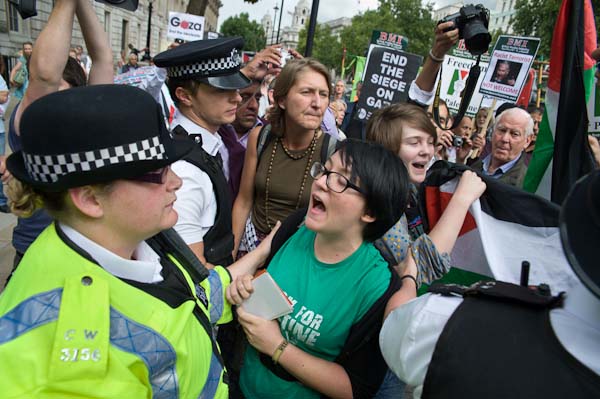
Police hold back demonstrators trying to push
towards the gates
more pictures
Several hundred protesters gathered in London opposite Downing St as
Israeli prime minister Benjamin Netanyahu was due to have talks with
Gordon Brown. They chanted '
Netanyahu, War Criminal!' and other
slogans, demanding that Israel dismantle settlements on Palestinian land,
end the seige in Gaza and stop their ethnic cleansing in East Jerusalem.
Protesters had applied for permission to protest and were allowed to do
so on the distant side of the Whitehall, subject to the restrictions on
freedom of SOCPA (The Serious Organised Crimes and Police Act) which,
for example ban the use of megaphones and other amplification. As the
demonstration started around 1.30pm a few demonstrators started to drift
across the road to wave placards and flags on the pavement in front of
the tall and well-protected gates of Downing St, where any protest is
illegal. As I began to photograph them they were joined by more people
with a megaphone, and for some minutes police simply watched as he and
others waved flags, chanted slogans and addressed the slowly growing
crowd of protesters who had by now gathered on the pavement by the
gates, as well as passing tourists.
After 20 minutes, police made their first move and came out to talk to
the protesters, informing them that their protest was illegal under
SOCPA and politely asking them to move across to the other side of the
very wide road to continue their protest. After a few minutes police
abandoned this polite approach and started pushing people to force them
to move, at which point another hundred or demonstrators streamed across
Whitehall from the legal demonstration on the other side to join them.
Although the police had managed to clear a small area of pavement in
front of the Downing St gates, this was at the expense of blocking much
of one side of the road with a larger crowd of demonstrators, and soon
traffic had to be stopped. The noisy demonstration continued, with a
smaller group including ant-zionist rabbis still protesting on the
'legal' side of the road. There were occasional bouts of shoving as some
protesters walked around or through the rather thin police line, but in
general it was a good natured demonstration and one elderly and confused
woman waving an Israeli flag was treated kindly by protesters - and she
had been there around an hour before a police officer insisted it might
be a good idea to for her to put the flag away in her handbag.
After police reinforcements arrived, Chris Nineham of 'Stop the War',
the organisers of the event, spoke to the crowd outside Downing St and
ended by suggesting they move back across the road. Few did, but by then
there were enough police to successfully push them across, and the event
continued with people on the pavement distant from Downing St.
Three people were arrested at this point; a police officer confirmed
that they had been warned earlier in the event that they were
demonstrating illegally under SOCPA but had continued, and that their
arrest had been delayed until more police were available. Later I heart
that there were two further arrests made later, but that all five were
freed between 11pm and midnight, having been detained for around 9
hours.
The SOCPA restrictions on demonstrations were ill-thought out and have
always angered anyone with a concern for freedom and justice. They were
introduced to try to get rid of the inconvenience and embarrassment of a
one man peace protest by Brian Haw just down the road in Parliament
Square. As I walked home I waved in his direction, still camped there
after 3006 days.
more pictures
Hackney Million Mothers March
Dalston to St John's Church, Hackney, London. Sunday 23 Aug 2009
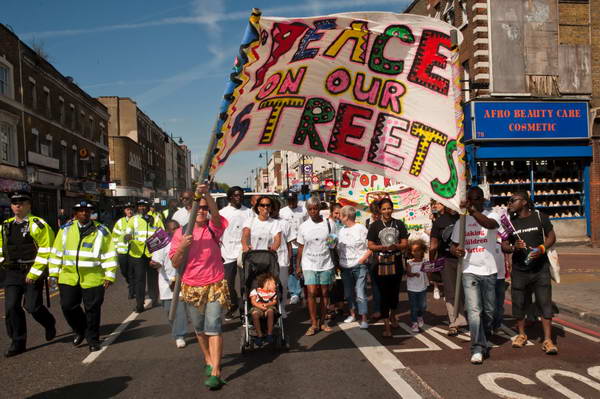
The march started along KIngsland High St, calling
for 'Peace On Our Streets'!
more pictures
Today in Manchester a the a Million Mothers March was taking
place to celebrate the 10th anniversary of Mothers Against Violence,
mothers from bereaved families who are having a real impact in reducing
gun, gang and knife crime. Women in Hackney decided to have a march on
the same day as a part of an international peace parade to join in this
celebration and to pledge action in Hackney over the issue.
The march was organised by Songololo Feet, Friend's
Charity, Hackney Council for Voluntary Service (HCVS),
International Action against Small Arms (IANSA), St. John's
Church and The Crib, a local community group which "delivers
creative and inspiring projects for young people in Hackney" and
brought a number of them to take part. Also present were people from the
Christian Party and a woman from the 100 Mothers Movement.
Perhaps because it was August and many people were on holiday, the
actual number taking place was rather disappointing, but it was enough
to make people turn round and look as it marched along Kingsland Road,
Dalston Lane, Graham Road and Mare Street to St John’s Church.
At the church there were a few more to greet the marchers and bring the
numbers up to aproaching a hundred. Several people addressed the rally,
including a mother whose son had been killed in a knifing, a young man
who had given up gangs and become a professional footballer, he had been
lucky to live after being stabbed, someone bringing support from the
Manchester Million Mothers March and the Speaker (a
councillor elected annually to carry out similar public engagements to
Mayors in other boroughs) from LB Hackney, Councillor Muttalip
Ünlüer. The event ended with singing from a group of six women on
the church porch.
more pictures
LIVE and FAME March Against Knife Crime
Whitehall to Kennington Park, London. Saturday 22 Aug, 2009
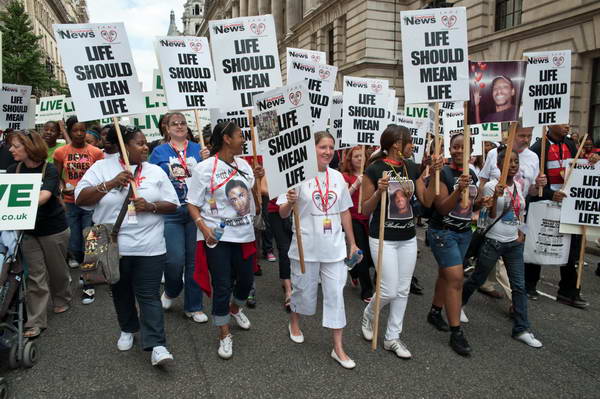
Families of crime victims from FAME were at the front of the march
behind the dark-suited Adventist leaders.
more pictures
Saturday's march through London against knife and gun violence was one
that raised many questions in my mind. Of course there can't be many who
would oppose the aim of cutting down the number of murders, the number
of young men and women who are killed, each one a tragedy for the
families concerned. But this was also a march that raised other issues
of crime and pubishment.
The event was organised by two groups; LIVE, a campaign of
the youth leaders of the Seventh Day Adventist Church was working in
partnership with FAME (Families Against Murders Escalating)
which was backed by the Southwark News. Adventists certainly have a
strong presence in black communities around the country, and as these
communities are disproportionately affected by stabbing and shooting of
young men and women, and their invovlvment seems very positive.
LIVE, "Living Intentionally Versus just (merely) Existing", "aims
to challenge, empower and motivate a generation of disadvantaged and
advantaged youth to live for all the things that is positive and turn
away all the things that are negative like the gun, drugs, and knives."
It's clearly a laudable aim, but there were aspects of the event that
worried me, not least the very large numbers of stewards in high-viz
vests and a slightly sinister dark-suited row of "leaders" at the front
of the march.
FAME was established in 2008 by Jackie Summerford from Walworth after
the brutal murder of her daughter Bonnie Barrett, a sex worker who was
killed in a Rotherhithe flat in 2007 by a man who has been described as
a 21st century "Jack the Ripper" and who the judge recommended
should serve a minimum of 30 years imprisonment. FAME's message on its
placards - and its main demand - is for tougher penalties, that "Life
should mean Life". While this would undoubtedly be welcomed by
the families of many victims it seems irrelevant to actually tackling
the situations that leads to these tragic deaths.
Problems with social services did not start with Victoria Climbié and
Baby P. One earlier case of a death that arose from their failure was
the tragic death of 18 month old Doreen Jane Mason in 1987. Like the
other cases it seems to have been a mixture of inappropriate and failing
management, overworked and undertrained social workers, inadeadequate
practices an irrational belief in 'management' as well as devious and
wicked clients.
Mason, renamed by relatives as Aysha Kuddissi after her terrible death,
was killed by mistreatment and neglect by her mother and step-father.
What is even more distressing is that although Christine Mason and Roy
Aston were found guilty and sentenced to 12 years for her manslaughter
(and 3 years for cruelty to run concurrently) in January 1988 they were
released on appeal in 1990. Although there was no doubt that the two of
them had been responsible for the death, it could not be established
which of them had actually delivered the fatal blow - and so both walked
free.
Also among the 36 portraits of those killed which were displayed on one
of the Fame placards was Tamzin Spalding, who died on 19 May 2008. Her
father, Michael Spalding, has complained to the IPCC about the conduct
of Northants Police over his daughter's death, claiming they failed to
investigate the case properly and that the investigating officer
misrepresented it to the coroner's clerk as "a straight forward
suicide." The family claim she was murdered and Mr Spalding says that
before her death he had complained to the police 31 times over six years
about her Colombian ex-boyfriend, who he alleges had made three previous
attempts to kill Tamzin as well as making death threats to her and her
family.
Clearly cases such as these show there are problems with the police,
the justice system and social services which need to be addressed, but
also and more importantly we need a cultural revolution to create a
society where people are more connected and care more for each other. We
have to look at ways of creating community.
more pictures
London Sri Murugan Chariot Festival
Manor Park, East Ham, London. Sunday 16 August, 2009
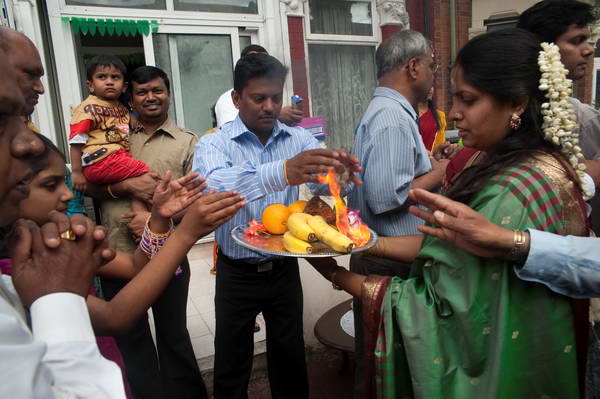
A family warms hands over the flame on the blessed fruit
more pictures
The Sri Murugan Temple in Manor Park, built in 2005, is the
largest South Indian Hindu temple in Europe and an impressive black
granite building to a traditional Tamil plan with three highly decorated
towers.
A highly decorated chariot carrying images of Hindu Gods (including the
Goddess Gayatri) left the temple early on Sunday morning and made its
way slowly around the streets of East Ham in a traditional 'Ther'
festival, followed by perhaps 5000 people, mainly members of London's
Tamil community. Along the route men and women stood in front of their
homes and businesses with plates or baskets of fruit to hand to the
temple priests riding on the chariot or walking in front for blessings
by the Goddess; metal trays bearing fruits were returned bearing a flame
and the families held out their hands to feel the warmth.
The chariot had two finely painted prancing horses at its front but was
pulled by two ropes, on the right by women and on the left by men, with
a large mixed crowd of followers behind. A group of musicians walked in
front. Those on the ropes and between them and many others walked
barefoot through the streets.
Men walking with the chariot carried short heavy knives which were used
to halve the coconuts offered for blessing, and at several places along
the route groups of men stood and threw large numbers of coconuts onto
the road to smash. Fortunately there appeared to be no injuries although
many of those around - myself included - were soaked by coconut milk and
the road was running in it.
Finally after almost four hours the procession arrived back at the
Temple where there was a very long queue for food, and I left for home.
more pictures
Southwark Youth Carnival Procession
Burgess Park, London. Saturday 15 Aug, 2009
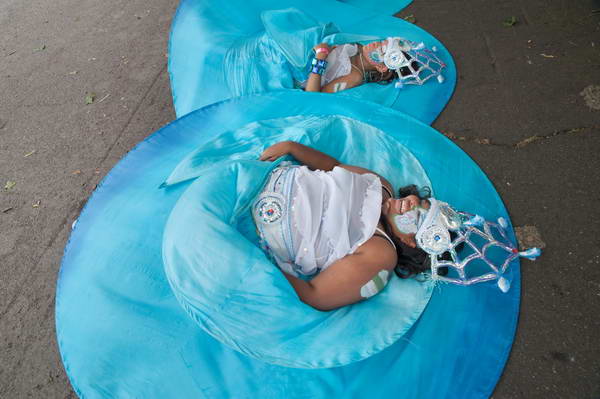
Dancers rest before the procession
more pictures
The procession was a part of 'The Mix' youth festival in
Southwark's Burgess Park. I went briefly to the festival but didn't take
any pictures. The procession formed up on Neate St at the east end of
the park, and then walked on the road around it. I photographed people
getting ready at the start and then as it went up Trafalgar Ave and then
along the Old Kent Rd.
Some of the groups taking part had worked on an 8 day carnival costume
course organised by Kinetika Bloco in Bellenden Old School.
The procession started roughly 45 minutes late, as some of the
performers had been touring around the borough and were held up in
traffic. I had to leave as it went down Albany Rd on its way to the
Camberwell Rd entrance to 'The Mix.'
more pictures
Day of the Broken Promise
Netherlands Embassy, London. Friday 14 Aug, 2009
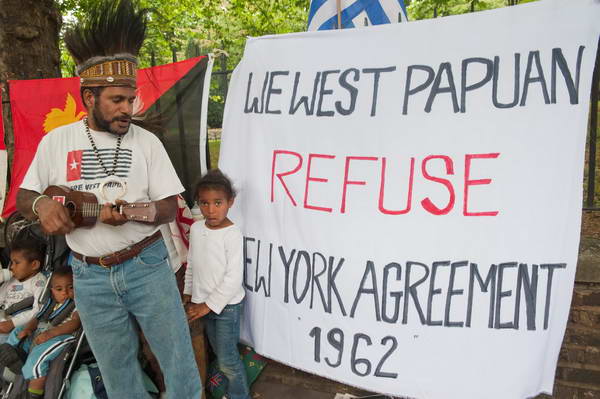
Benny Wenda, West Papuan independence leader and chairman of the
Koteka Tribal Assembly
more pictures
Benny Wenda, West Papuan independence leader and
chairman of the Koteka Tribal Assembly, and most of the rest of the
small handful of West Papuans living in Britain demonstrated opposite
the Netherlands Embassy in London, to mark the anniversary of the 'Day
of the Broken Promise', 15 August 1962.
The western half of New Guinea became a Dutch colony in the nineteenth
century, but by the 1950s they were moving towards giving it
independence. However the Indonesian goverment claimed the country and
threatened invasion after then Dutch set up an elected government of
West Papua in 1961.
Indonesia was backed by military aid from the Soviet Union, and the
Kennedy administration in the USA wanted to prevent further movement of
the country towards the Soviet bloc, so pressured the Netherlands into
signing the 'New York Agreement' with Indonesia in August 1962. This
allowed Indonesia to take over the administration of the country but
provided for all the adult population of West Papua to vote at a later
date on whether they wished to become independent.
The Indonesian army moved in on 1 May 1963 and began a programme of
repression and human rights abuse against the people. In 1969 they
rounded up and detained just over a thousand West Papuans as
representatives of the people and enusured that they voted for rule by
Indonesia by threats, including at least in some cases that they and
their families would be killed unless they did so.
The Indonesian government made it impossible for the UN represenatative
who was supposed to oversee the election to operate properly, and banned
most foreign reporters. Although it was clear that the vote did not
reflect the will of the West Papuan people - and had failed to meet the
terms of the agreement - which had been ratified by the UN - it was
approved by the UN General Assembly.
Since then there have been many reports of repression by Indonesia in
the country, including murder, political assassinations, torture, rapes,
dissapearances and bombing. The government also had a programme of
resettling migrants from Indonesia in the country, apparently aimed at
producing an Indonesian majority population.
West Papuans have engaged in both civil disobedience - particularly
around cermonial raising of the West Papua flag (the Morning Star) as
well as armed resistance.
Wenda was jailed for displaying the West Papuan flag but managed to
escape and gain asylum in the UK. Estimates of the number of West
Papuans killed by Indonesian repression are in the hundreds of thousands
(400,000 according to the Free West Papua Campaign), and in 2006, 43
refugees landed in a traditional canoe in Australia, claiming the
Indonesian military was carrying out a programme of genocide.
Despite a widespread recognition of what has been happening, there is
little international support for West Papua. The country has the world's
largest copper and gold mines, largely owned by US Compnay
Freeport-McMoRan with UK based Rio Tinto Group also involved.
Today's demonstration was peaceful and tuneful, with Benny and Maria
Wenda and others playing instruments and singing traditional West Papuan
songs opposite the embassy.
A Dutch diplomat came across the road to talk to the demonstrators and
receive a letter demanding that the Netherlands and other governments
insist on the proper implementation of the 1962 agreement, with a free
and fair independence referendum involving all West Papuans overseen by
the UN. Papuans feel they were let down by everyone involved, but
particularly by the Dutch; "We trusted you and we believed in you.
But you betrayed us."
The diplomat spoke for a few minutes with the demonstrators and was
interested to see a feature on the rebel army there which appeared in
today's Independent
on display.
After the demonstration at the Netherlands Embassy the protest was
moving to the Indonesian Embassy in Grosvenor Square, where the West
Papuans hold regular protests.
more pictures
Rally For Vestas Jobs
Dept of Energy & Climate Change, London. August 6, 2009
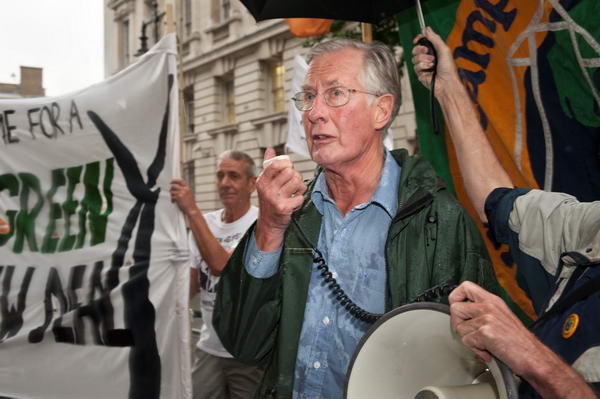
The rally outside the Department of Energy and Climate Change in Whitehall
on Thursday evening started in light rain, but it was pouring by the time
it finished. Despite the weather, the 80 or so present listened intently
to speeches from a Vestas worker, trade union speakers from the RMT, PCW
and Billy Hayes of the Communications Workers Unions, as well as former
Labour Secretary of State for the Environment Michael Meacher MP and Green
Party GLA member Jenny Jones, who arrived at the event by bicycle.
Despite the government having spent thousands of billions propping up
the banks it is unwilling to put up the much smaller amounts needed to
support green industries. The problems of Vestas are indeed very much of
the Government's making, with its failure to put it's money where its
mouth is on green energy policies, relying on hot air rather than
support for wind power and other alternative energies.
Making wind turbines is a profitable business, and will become even
more so, but unless action is taken - such as nationalising Vestas, at
least (as with the banks) on a temporary basis, the UK will be buying
them from abroad rather than making money selling them to the rest of
the world.
more pictures
Olympic Site Update - August
Stratford Marsh, London. August 6, 2009
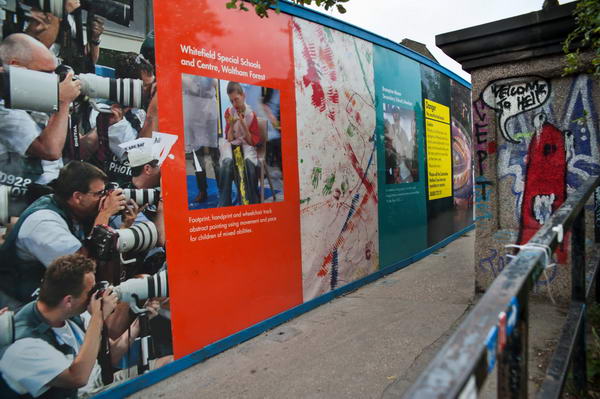
'Welcome to Hell' says the graffiti at Hackney Wick - and it certainly
looks like hell for photographers
more pictures
The process of sanitising the Greenway (Northern Outfall Sewer) which
forms an elevated footpath through the centre of the site is now in full
swing, though I suspect for the actual fortnight they will be relying on
tons of air freshener rather than being able to entirely lose its sweet
and sickly smell. But they are apparently clearing most of the
vegetation that made the 'Greenway' green and reasonably pleasant.
For the next few months the whole section between Stratford High Street
and the main line will remain totally closed, and currently between the
railway and Hackney Wick all but a relatively narrow strip is fenced
off, with security men roughly every 50 yards standing or sitting with
very little to do. Most of the larger bushes and trees have little bits
of fence around them with a notice saying they are to be retained. The
diversion goes round by Pudding Mill station, which adds perhaps a
quarter of a mile to the route,and there are other diversions planned
for later dates.
Because of the fencing it is no longer possible to photograph the
stadium and other building works to the north of the Greenway from this
viewpoint. The best view of the stadium itself is now from Hackney Wick
What you can see of the Bow Back rivers look in pretty poor shape, and
the Lea Navigation itself seems to be suffering from more build-up of
weed than usual. The graffiti around Hackney Wick is still flourishing
though.
more pictures
Stop East London Arms Fair
Clarion Events, Hatton Garden, London. August 6, 2009
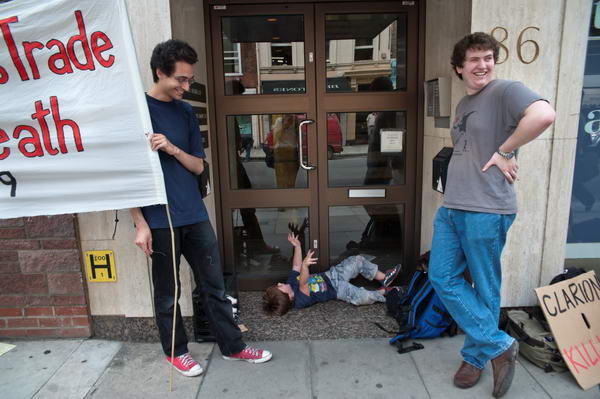
A young demonstrator lies down in front of the office
door
more pictures
Demonstrators from 'DISARM DSEi' picketed the offices of Clarion
Events in Hatton Garden, London on Thursday lunch time, calling
for an end to the Defence Systems & Equipment international
(DSEi), the world's largest arms fair, which Clarion are organising at
ExCeL in East London next month.
DSEi is a vast event - in 2007
there were over 1300 companies from 40 countries exhibiting weapons
(though the Space
Hijackers were refused admission to sell their tank) and related
equipment and a total of over 26,000 visitors to the show.
The arms trade results in millions of men, women and children being
killed in conflicts around the world. According to UNICEF, in the ten
years between 1986 and 96, two million children were killed in armed
conflict and a further six million injured, many permanently disabled.
British companies are among those making high profits from equipment
designed to kill people, and our High Street banks invest huge amounts
in arms companies.
Demonstrators handed out leaflets to the many passing by, explaining
what went on the what appears to be an office for the diamond trade.
Many of them were surprised to find that our government encouraged such
activities, and some stopped to talk with the pickets. The youngest
member of the group provided some entertainment running around with a
small plastic boomerang, hardly a dangerous weapon and unlikely to be
found at arms fairs. At one point he staged a short 'die-in', blocking
the entrance to the offices by lying on the floor in front of the door,
but otherwise the demonstration was restrained and entirely peaceful.
Police watched from across the road, one making copious notes and
apparently taking a great deal of interest in the four press
photographers present, who were mainly just standing around talking to
each other as there wasn't a great deal to photograph. There were also
two officers, one armed with what a colleague identified as a GLOCK
semi-automatic pistol on hand a few yards down the street, although it
was hard to see any need for this - the demonstrators are after all
opposed to the arms trade. This was an event with no possible terrorist
threat or threat to public order, and it looked very much a case of boys
and toys. Only a few years ago we prided ourselves that our police were
not armed; now they seem to want guns even to help old ladies across the
road. The only active duty they took during the protest was to escort
one - or possibly two - men into the offices, rather pointless as they
would otherwise have walked through the picket without being noticed.
The protesters rolled up their banner and left as arranged after an
hour, with a police car following them at walking pace along the street
and along High Holborn as they went towards a pub.
more pictures
London Remembers Hiroshima
Tavistock Square, London. August 6, 2009
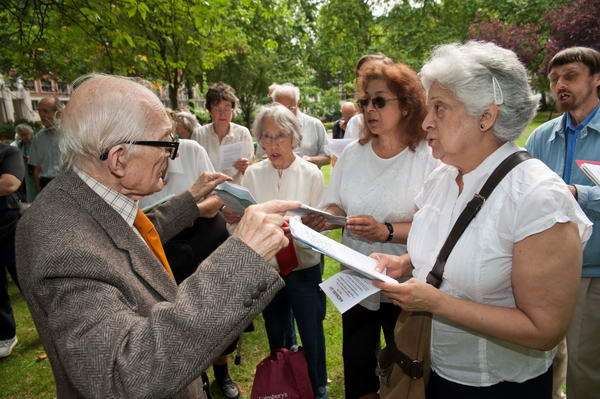
The Workers Music Association was one of two socialist choirs at the
event
more pictures
The London nemorial ceremony, organised by London CND, took place in
Tavistock Square, next to the cherry tree planted there by the Mayor of
Camden in 1967 to remember the victims of Hiroshima. The current Mayor
of Camden, Cllr Faruque Ansari was the first speaker, after a brief
introduction by Islington MP Jeremy Corbyn and a peace song by the
Workers Music Association, and he was followed by Frank Dobson MP and
Bruce Kent, Vice President of CND.
Speakers called for Britain to abandon our Trident missiles and not to
waste billions on their replacement. South Africa is the only country
yet to renounce nuclear weapons and we could lessen the risks of a
future nuclear conflict by giving up our expensive and obsolete systems.
A second socialist choir, Raised Voices also performed, and were
followed by Pat Allen of Highbury and Islington CND talking on the the
international campaign for a ban on atomic weapons he was involved with
in the years before the foundation of CND. and Ann Garrett of Bromley
CND reading three of her poems. It was a surprise to also hear a
14-year-old girl, Sonia Azad speak so confidently. I had met her a few
months earlier when I was photographing and she was videoing CND's 'Wedding
'Die-In' Against Afghanistan War' at the British military HQ at
Northwood in May. The two socialist choirs then joined together for a
further anti-bomb song, 'Against the Atomic Bomb' which puts words by
Ewan McColl to a Japanese melody.
Lindsey German, convenor of Stop the War gave a typically forthright
performance and reminded us of the need to keep demonstrating against
the war in Afghanistan - particularly in the demonstration planned for
24 October. Len Aldis talked about the success of the 'Mayors for Peace'
campaign but urged all of us to get our Mayors to join if they have not
already done so, and Silvia Swinden talked about the World March for
Peace and Nonviolence, which starts on 2 Oct 2009.
Those present were then invited to lay flowers beneath the Hiroshima
cherry tree during a minute's silence to remember the victims of
Hiroshima and Nagasaki, after which choirs and all those present joined
in singing "Don't you hear the H Bomb's Thunder." I had to rush
away at this point to another event, but people were invited to stay for
a picnic in the park after the ceremony.
more pictures
Ian Parry Award 2009
Eastcastle St, London. Tuesday 4 August
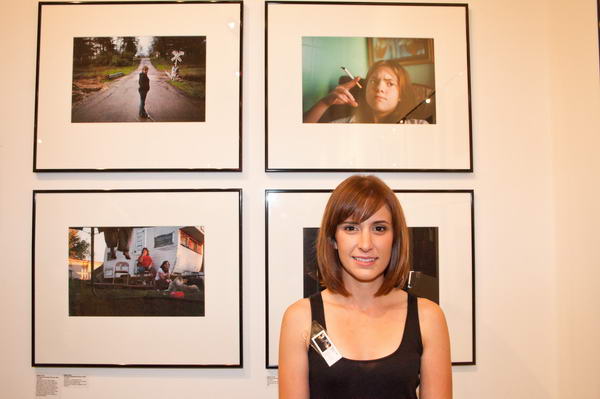
Award winner Maisie Crow in front of her work
more pictures
It was a good show - and it continues for a week at the gallery. You
can read some of my thoughts about it on >Re:PHOTO.
Although there were a lot of people there I recognised (and often wished
I could put names to - my memory sometimes seems to be going very fast)
none of the photographers I meet regularly when I'm working were there.
That there seemed to be very few of the working photojournalists who
come to events such as Photoforum or attend NUJ events seemed a little
odd given the nature of the award. It perhaps says something about the
way this country's photographic establishment regards photographers.
I was disappointed that Don McCullin wasn't able to make the evening.
But there were a few people it was good to meet again. Brian
Griffin for one, and I was pleased to hear that he is to be
photographing people involved in the Olympics - at least one thing to
look forward to in the run up to 2012.
Since I intended to write about the award on >Re:PHOTO I'd taken a
camera with me, though by the time the awards were made I'd sampled the
rather better than average for openings offerings from Eminent Wines,
and was not in the best state to operate machinery; fortunately the D700
works pretty well on autopilot and occasionally I managed to press the
button at an appropriate time.
more pictures
Carnaval del Pueblo
Elephant & Castle, London. 2 August, 2009
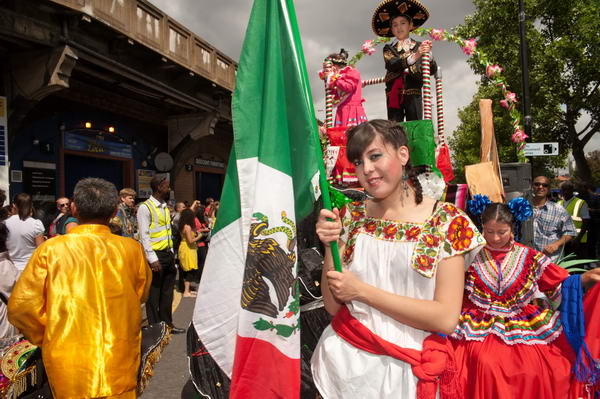 The
carnival parade forms up on Elephant Road
The
carnival parade forms up on Elephant Road
more pictures
The London borough of Southwark is home to many of London's Latino
communities and in 1999 supported the first 'Carnaval del Pueblo',
a three mile carnival procession followed by a huge free festival in one
of south London's largest parks. In the ten years since then it has
grown into what is described as "the largest Latin American out-door
festival in Europe" and attracted support from the Mayor of
London and the Heritage Lottery fund among others.
The colourful procession started from the Elephant and Castle and
included floats, music and traditional costumes from 19 Latin American
countries including Bolivia, Brazil, Colombia, Cuba, Ecuador, Mexico and
Peru with around 20 different community organisations and other groups
providing floats. I photographed the performers getting ready for the
parade and left as it started out down the Walworth Road to Burgess
Park.
more pictures
Iran Protest at Press TV
Westgate House, Hanger Lane, London. 2 August, 2009
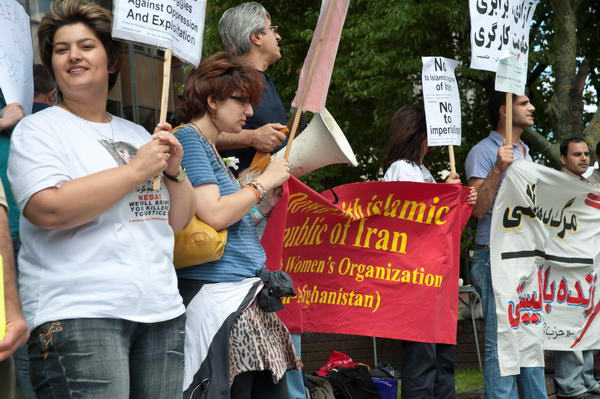
Demonstrators opposite Press TV studios in West London
more pictures
Around 40 British and Iranian socialists and trade unionists protested
outside the west London studios of Press TV, the English language TV
station funded by the Iranian government on Sunday 2 August to highlight
the plight of political prisoners in Iran.
The protest at Westgate House overlooking the A40 Hanger Lane
roundabout at was organised by Workers' Liberty and the Worker-communist
Party of Iran - Hekmatist and The 8 March Women’s Organization (Iranian
– Afghanistan.) (March 8 is International Women's Day, first celebrated
by the Socialist Party of America a hundred years ago in 1909.)
In the June protests in Iran, thousands were arrested and possibly a
hundred people killed. Around 750 are still in prison and many have
simply disappeared. Show trials of some are now taking place. Amnesty
reports that four have died in prison, and torture is routine, with some
dying from its effects after their release.
Last Thursday there were further protests to mark the 40 days since the
killing of protesters including Neda Agha-Soltan, with protesters being
beaten, arrested and one reported killed.
Press TV's reporting of the events has been one-sided propaganda in
favour of the regime and failed to report the protests when - thanks
largely to citizen journalism for Iran - they were headlining other
media around the world. The demonstrators expressed their support for
journalist Nick Ferrari who resigned his job as a presenter at Press TV
and Jeremy Corbyn who withdrew from a program because of the station's
biased coverage of the repression in Iran.
Among the demands made in speeches from Iranians and UK supporters in
English and Farsi were the unconditional release of all political
prisoners and an end to torture as well as the arrest and trial of those
responsible for the attacks and killing of protesters. Protesters also
called for freedom of speech, a free press and free trade unions and
political organisation, as well as equal rights for women in all aspects
of life and the abolition of compulsory veiling. They demand a
separation of religion from the state and a society where all are free
and equal.
more pictures
top of page
All pictures on this section of the site are
Copyright © Peter Marshall 2009; to buy prints or for permission to
reproduce pictures or to comment on this site, or for any other
questions, contact
me.



















